An extraordinary teenager came to world’s sight in the summer of 2019 after the exquisite performance against Paris Saint Germain in Ligue 1, and the footballing auditorium questioned who’s the guy dancing between highly-paid midfielders?
The name was Eduardo Camavinga, and the youngster born in Angola but raised in France played toe to toe versus Marco Verrati, Marquinhos and Angel di Maria in the midfield and sent them home with zero points in their pockets. That game pointed him out as the next big thing in the country of world champions, as he, not long after that, got to represent them in the U21 squad.
He’s seen as the successor of today’s midfield that brought „Les Bleus“ back to the top because of his physical and technical abilities along with his understanding of the play. The 17-year-old entered the Rennes first team this year and stuck in it with his great performances, week in week out showing that he deserves dithyrambs that are served on him. Even though he is planned to step into the boots of N’Golo Kanté, Paul Pogba and Blaise Matuidi, he’s the mixture of all three of them and his career could easily go through plenty of different paths.
Camavinga is a two-way midfielder with characteristics of the modern best players in that position. His age gives him even more value because although he is very young, he already has some major qualities that put him on the biggest teams’ shortlists for the upcoming transfer windows.
His side managed to win against some tough opponents in both the domestic league and in Europe this season, with the youngster playing a huge part in those duels. It is important to acknowledge his maturity of ideas and sense for the game when talking about his potential, so he will probably become one of the bests out there if he keeps working hard and continues his progress this way.
But, what’s the fuss about Eduardo Camavinga?
Movement and play organisation
The French midfielder is an embodiment of the modern football-control idea in that part of the pitch. He plays as a true metronome, building the actions for his team and organising the central areas in the way he sees them. That is possible because of his great motions in his space of manoeuvring, as he is always close to the action in the zones for which he is in charge.
Camavinga works all around the field, focusing himself on the midfield but floating in a non-strict manner and positioning both in higher half-spaces and coming closer to his goal in order to be included in the build-up.

As we can see in his heat map, the youngster is mostly present in the central square of the pitch where he participates in all of his duties. His higher movements are also related to the pressing game and fake runs, which he uses to create room to his teammates in the danger zones.
The main job of this player is to be included in the opening stages of the attacks and to organise them in the following ones. His positioning in those situations is on a very high level and he very often finds the room between the lines to break the opposition’s pressing. The defensive midfielder comes close to his defenders when they are in possession and repeats good gap-runs which enable his team to move forward.
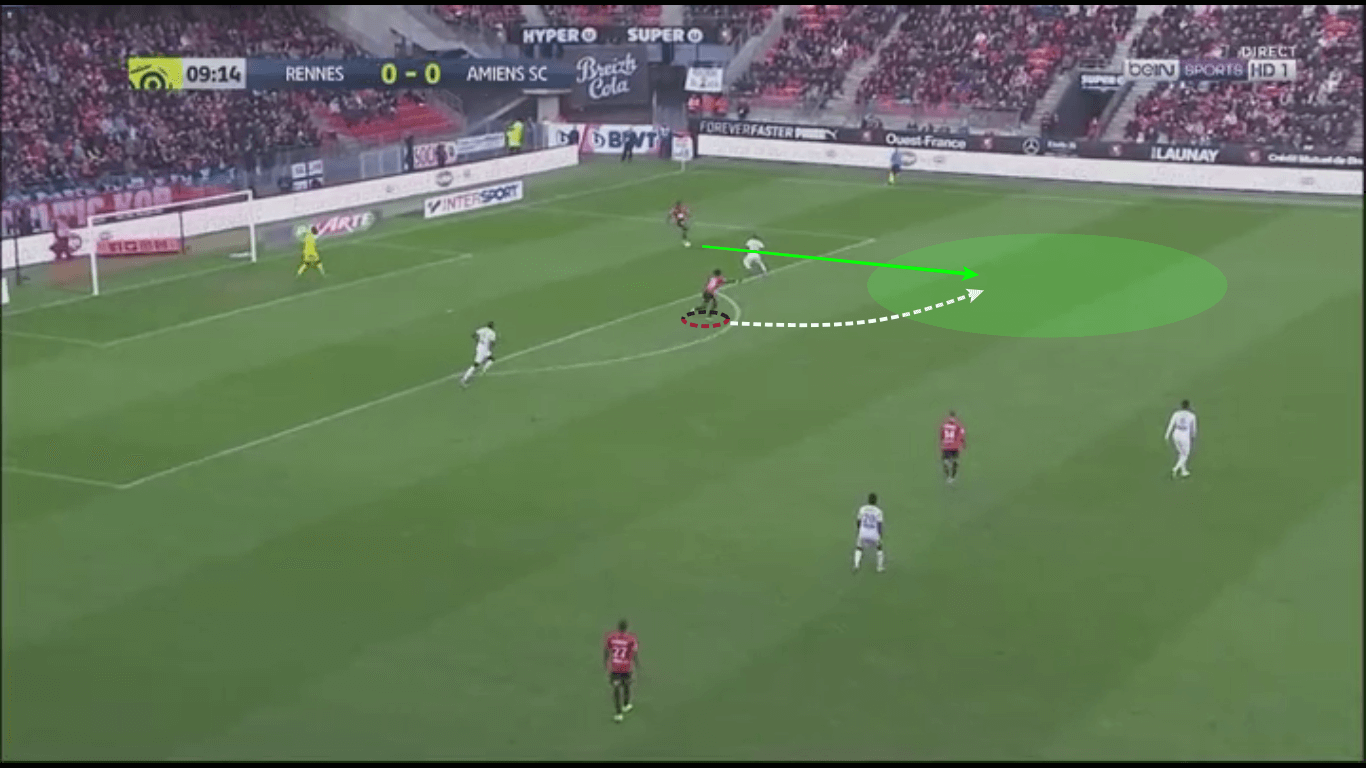
Camavinga’s body positioning and movement make it possible for Rennes to play across the pitch in under-pressure situations. He time and again uses the blind spots of the opponents to run into the space in which he can get the ball so he could organise the progression of his team’s play.
When it comes to higher zones, his involvement in actions remains the same in some manner, but in some quite difficult. In the central area of the pitch, he is the main rhythm-controller due to his vision and sense for the play because he knows when to overload and when to switch the side if one gets overcrowded.
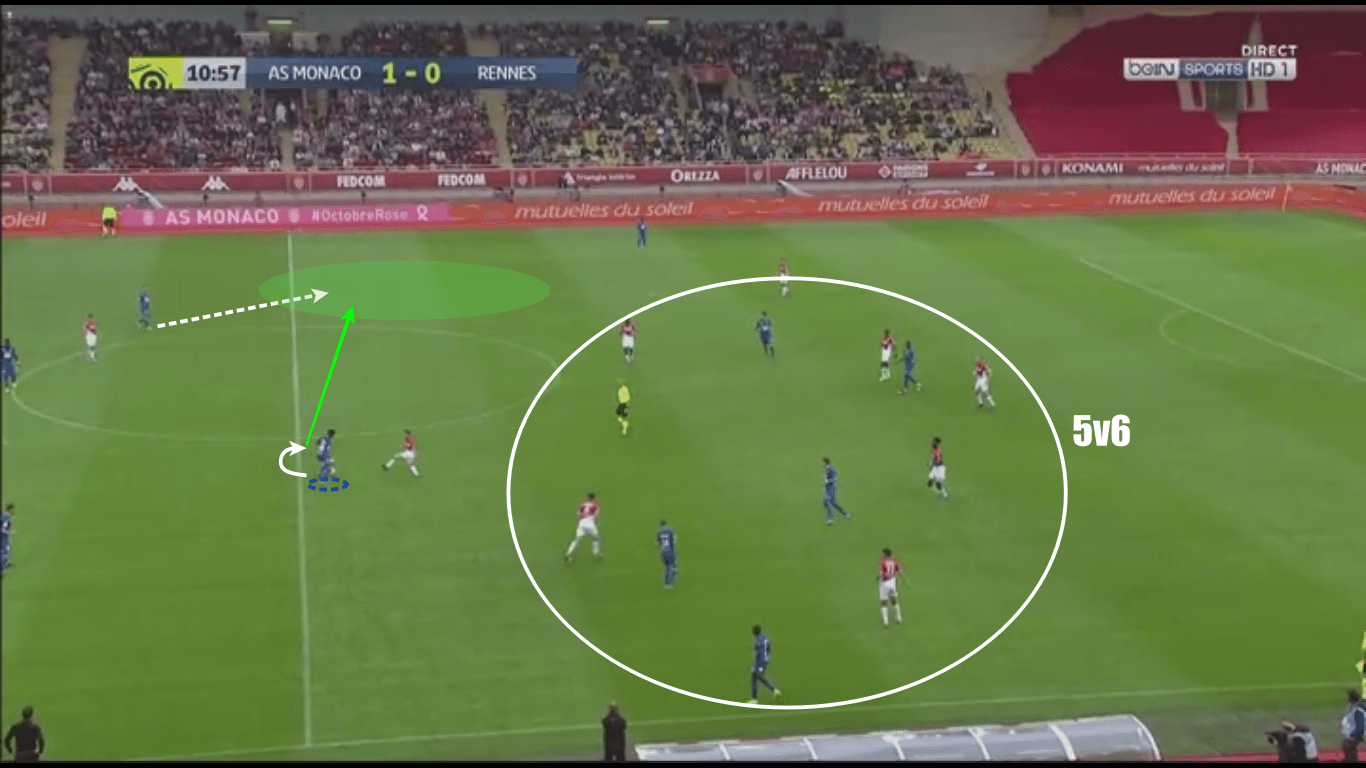
In the scenario as the one shown above, the youngster notices that the ball can’t go through the right-hand side because of the numerical inferiority of his team so he rationally decides to send the ball to the opposite one. His fast feet enable him to repeat those actions and not to panic under pressure since he possesses good technique and great ball control, which can be seen in his fast receptions and turns with the ball.
Camavinga is not only useful with the ball in his feet, but also with his fake movements. He opens a lot of space for his teammates in various areas of the pitch by performing dummy runs in order to get the defenders’ attention.
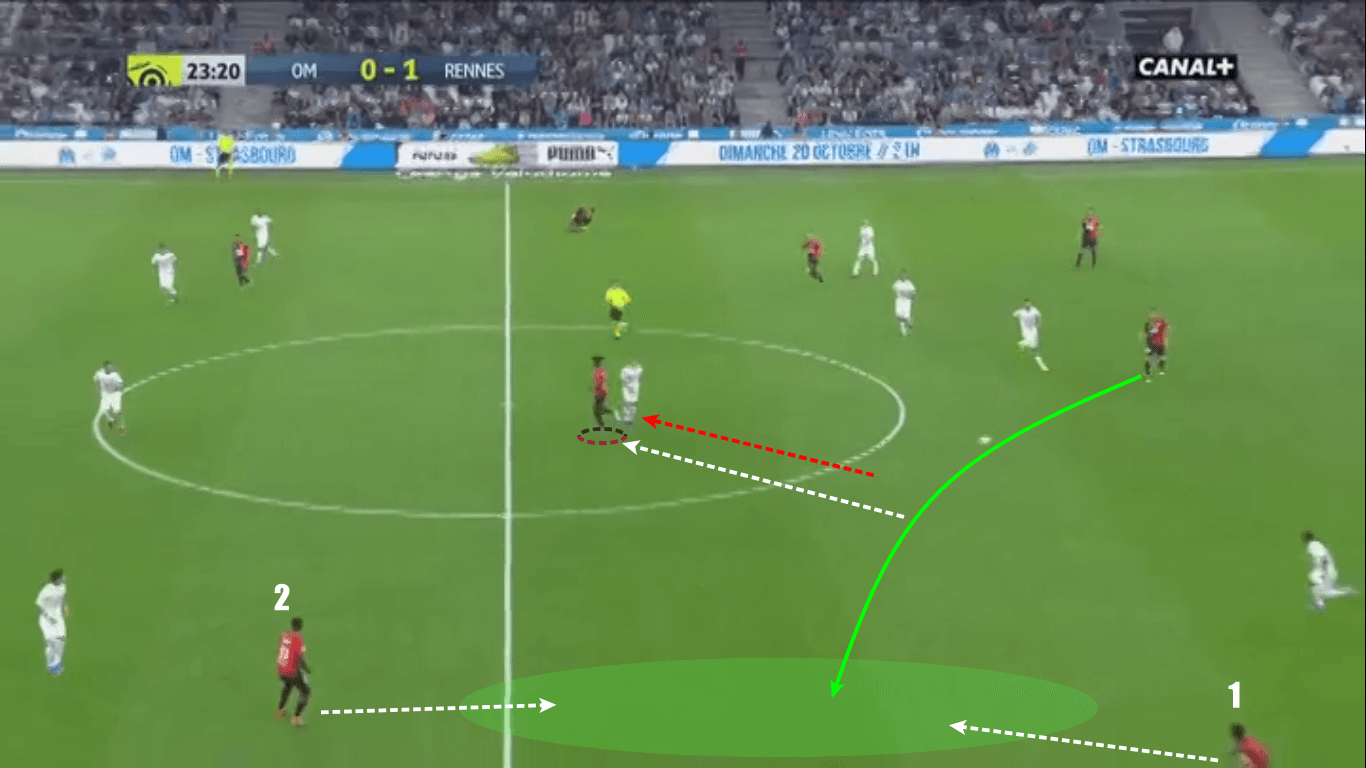
His constant motions are of great importance for his side and he frequently makes it possible for them to organise their actions even though he isn’t physically included in the possession. The midfielder opens a lot of passing lanes with his runs and allows players in a better position to get the ball.
Although he is mainly positioned in the midfield square, he now and again has a tendency to pull himself to the flank in order to initiate fast-forward plays. As he is very good in both negative and positive transitions, his pace allows him to participate in counter-attacks in which he often finds himself next to the sidelines.
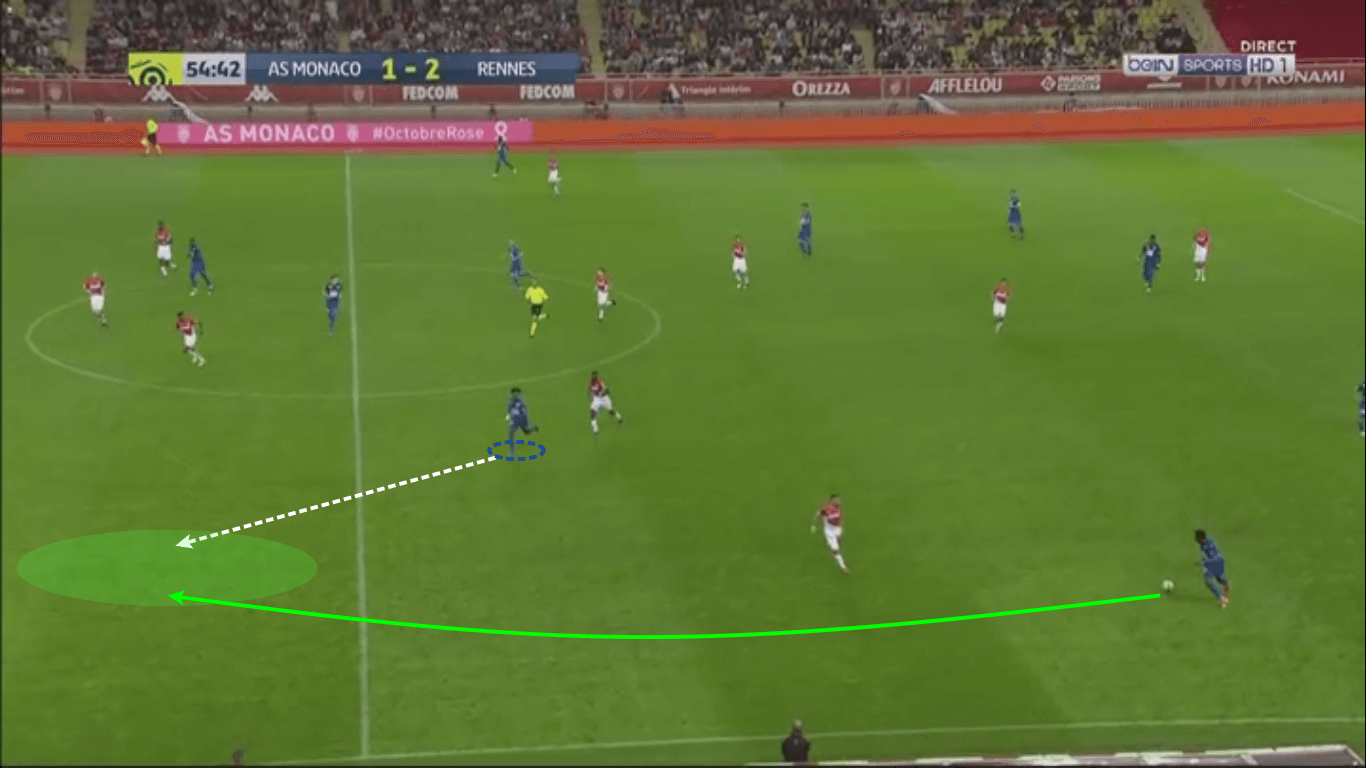
Those repeated runs speed up Rennes’ game and help them break the lines easier. From these positions, Camavinga mostly decides to go with deeper passes or to try and find his teammate in the central or inner corridor.
Sometimes, he also plays an important role in the final third of the pitch when he comes closer to the action to provide his team with an extra-option. The youngster senses the gaps in the opponent’s defensive structure and habitually tries to utilise them by coming closer and supplying his attackers from those spaces.
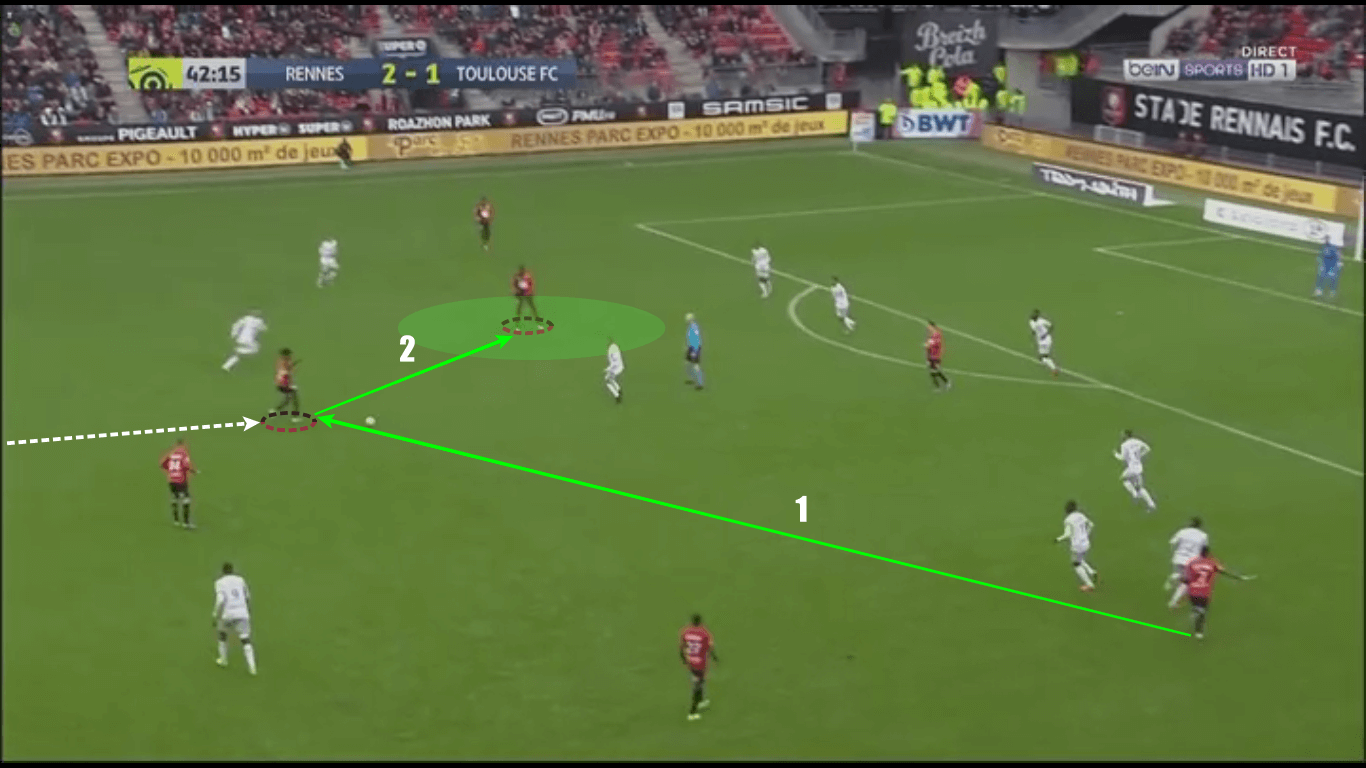
In the picture above it is shown how the Frenchman makes the best of this scenario setting himself in a great position to get the ball and sending a fast pass to his player in the half-space at the edge of the box. This link-up quality he has is a good indicator of what he can become in the future, as it is a good basis for him to progress in that way and become an all-round midfielder.
Playing under pressure and tempo-dictating
Camavinga is quite cold-blooded for his age and he doesn’t panic when he gets in difficult situations with no clear winning outcome in his sight. He manages to think maturely in those settings and finds the optimal solution, thriving under pressure and being secure on the ball.
His stats in the passing section are impressive if we perceive him as a defensive midfielder with an attacking attitude. Although he likes to move upwards, he controls the play by sending a huge number of balls to the flanks or backwards and his numbers clearly show that he balances the actions of his team with his well-picked passes.

The youngster is versatile in his decisions and uses various passes in order to dictate the tempo of play. As we can see, he has a high pass accuracy rate of 89% and all of the other percentages in this segment of the game are higher than 70% and yet well-balanced.
His vision and sense for the game make it possible for him to control the rhythm of the matches as he is really good at noticing the environment around himself. Camavinga’s decisions are mostly perfectly timed and he usually passes only to teammates in the best positions to receive them.
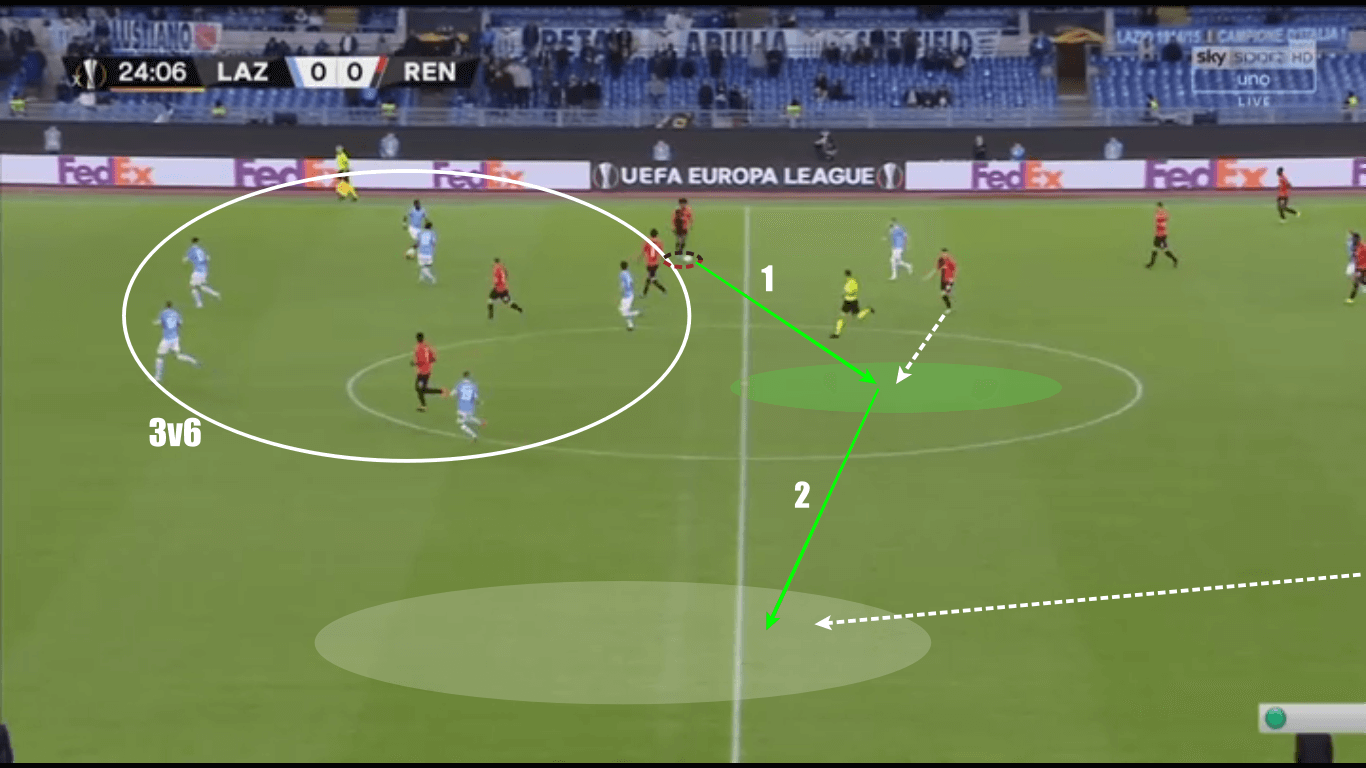
In the picture, it is shown how he commands Rennes’ action by observing the setting around him and playing it towards the best-suited player at that moment. The Frenchman time and again gets the good insight of the situation so he decides if his team will move quickly or play it slower and circle the block. He sees the numerical inferiority and sends the ball to the opposite side which allows his team to progress through the unguarded part of the pitch.
The 17-year-old doesn’t have issues when he’s put under pressure by numerous opponents, and manages to keep his cool, mostly due to good ball-control skills and on-the-ball secureness. Even when he’s faced towards his own goal, he knows how to beat guards who have a surplus over him and is quite lucid in those situations, as he often tries to beat them with dribbling.
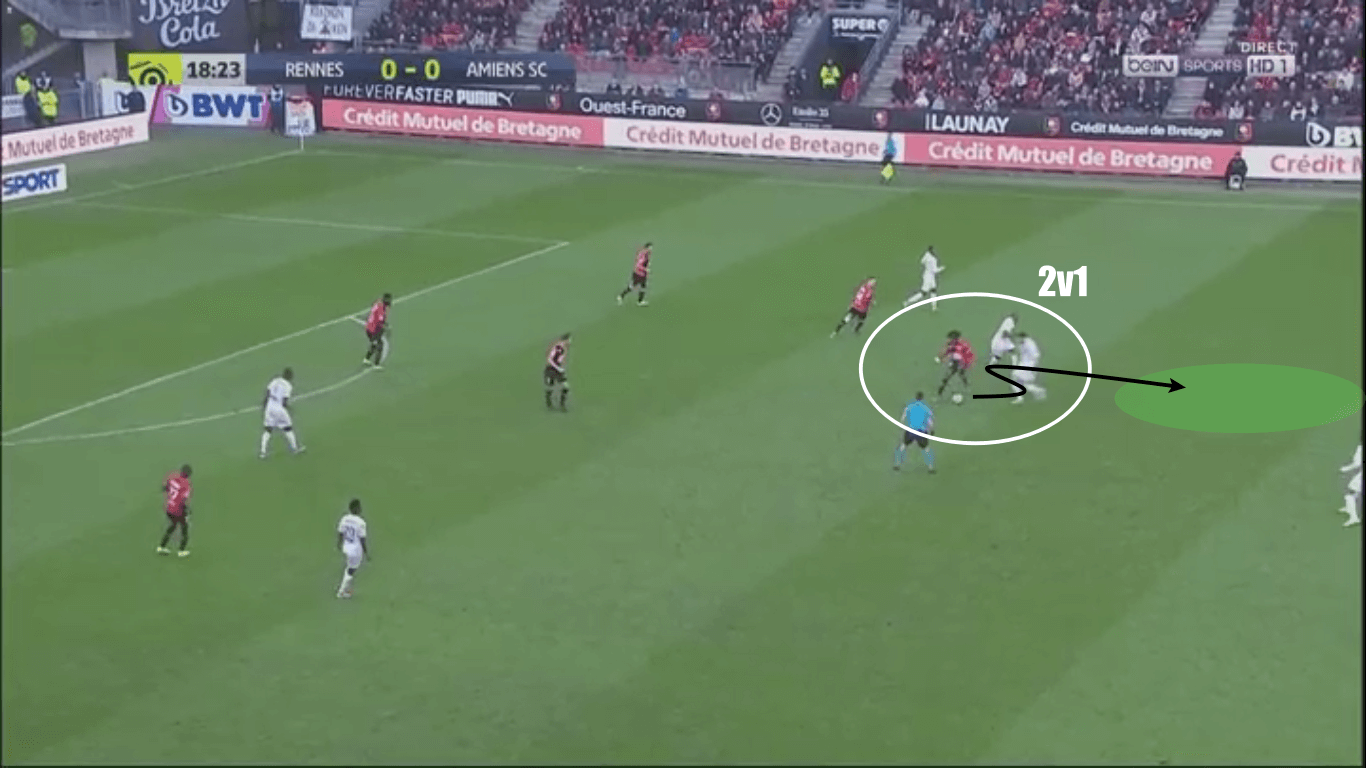
Camavinga frequently thrives in those scenarios making the most for his team and opening good counters or transitive attacks. He is familiar with conquering space with the ball in his feet and, because he is good under pressure, doesn’t run away from direct play against numerically superior opponents. The midfielder also often finds a way to move the ball forward from these restricted areas and manages to supply his attackers in fast transitions.
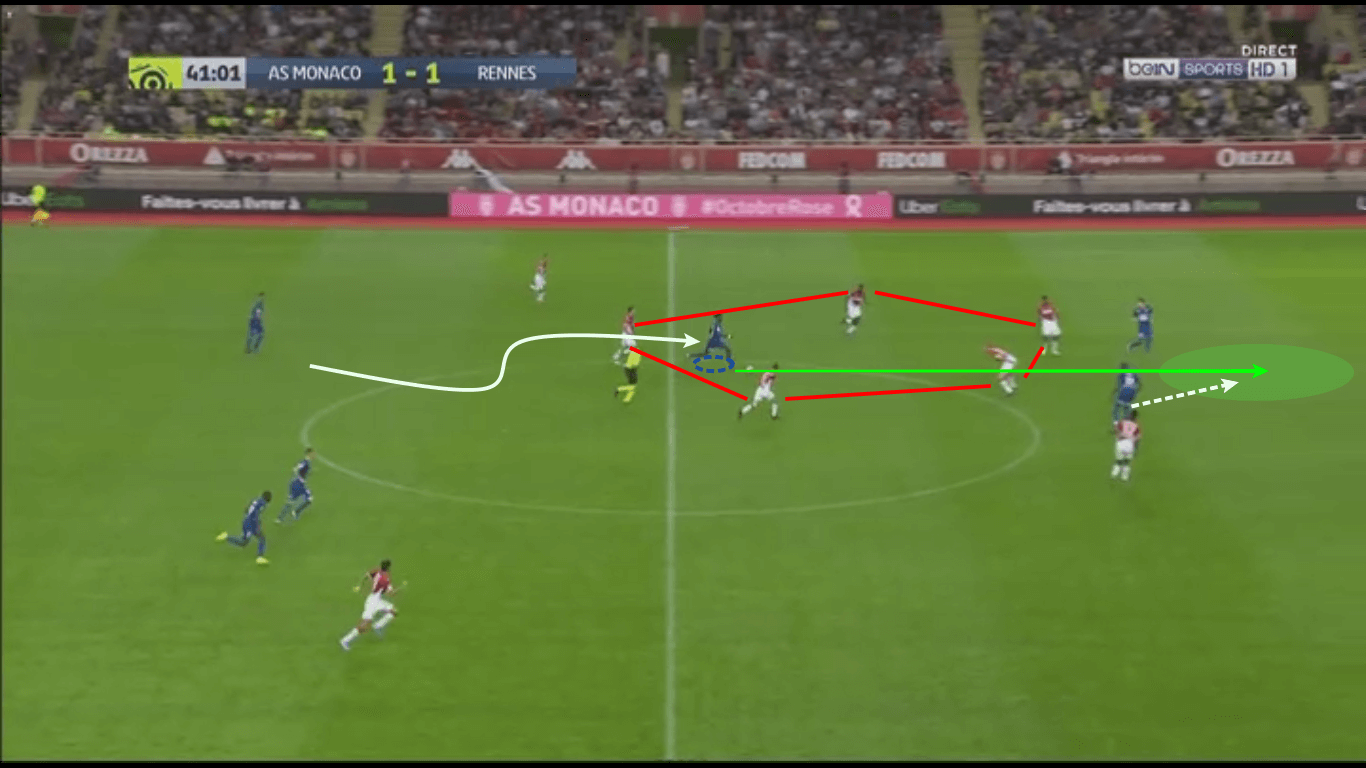
However, those actions aren’t the most common ones for him because he mostly decides to go with a fast passing game in order to dictate the play. He oftentimes finds himself pressurised and that happens in various zones on the field – in the opening stages of the actions as much as in higher progressive ones.
In all of the areas, the pattern of his decisions stays the same – his vision allows him to pick the best possible solution and to break the opponent’s structure with just one pass enabling his side to move towards the goal.
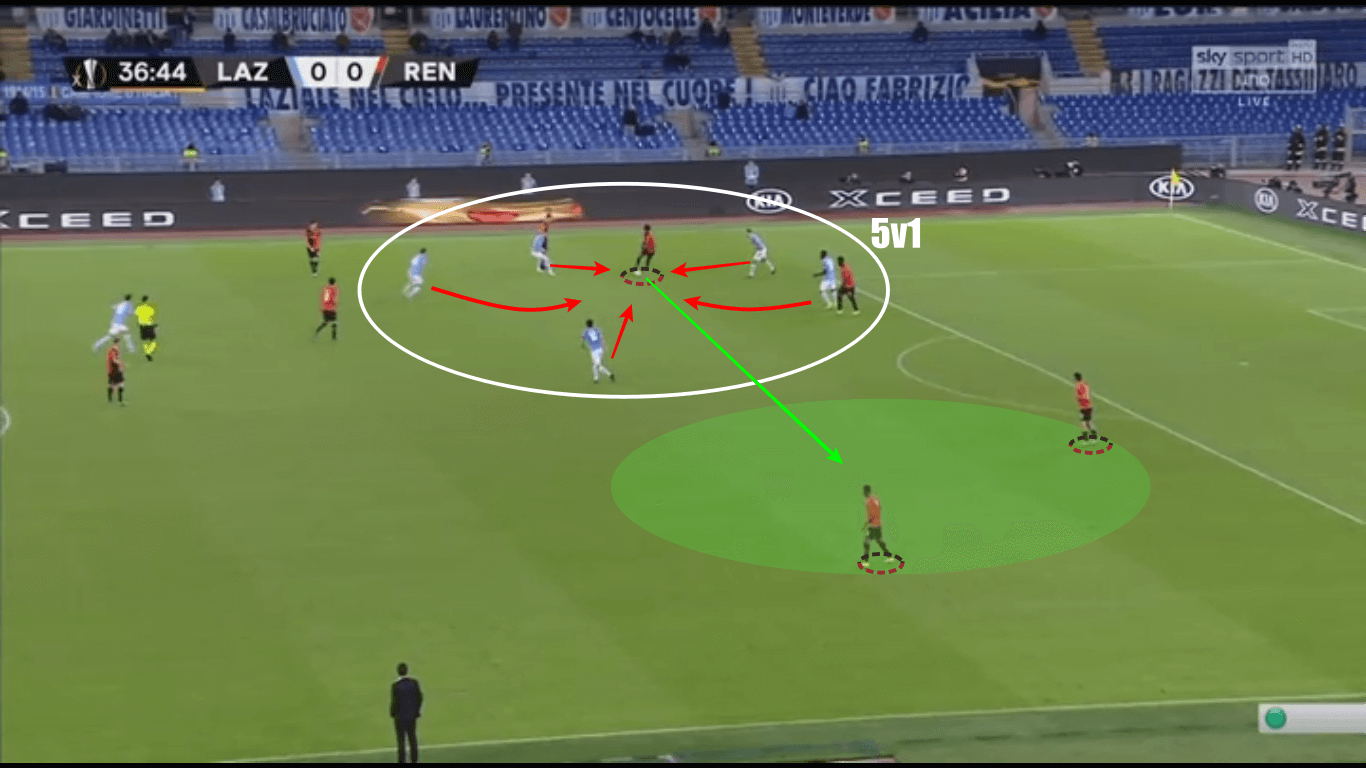
As we can see, settings as the one above are frequent for Camavinga, but he doesn’t panic and manages to find the open player on the other side so their attack can continue down the left-handed flank. His calmness on the ball when the opponents are heading for him indicates that he is well-drilled both in his head and his feet and that he could, if he isn’t already, become a high-level action opener.
Covering depth and providing support
Playing with the ball isn’t the only thing this youngster does well as his out of possession game is also of high quality. Camavinga is preferably the defensive midfielder who likes to control the situation in the central zones of the pitch and who tends to position himself in front of the ball and as security providing midfielder to his teammates who are positioned higher up the pitch.
His main job is to play as a second line of defence in the midfield, providing extra help if the first line gets broken and supporting his team’s players if they need him to press together with them. He always stays close to the action, watching for the closest opponents and staying on a reasonable distance from them so he can approach them with speed and regain possession for his side.
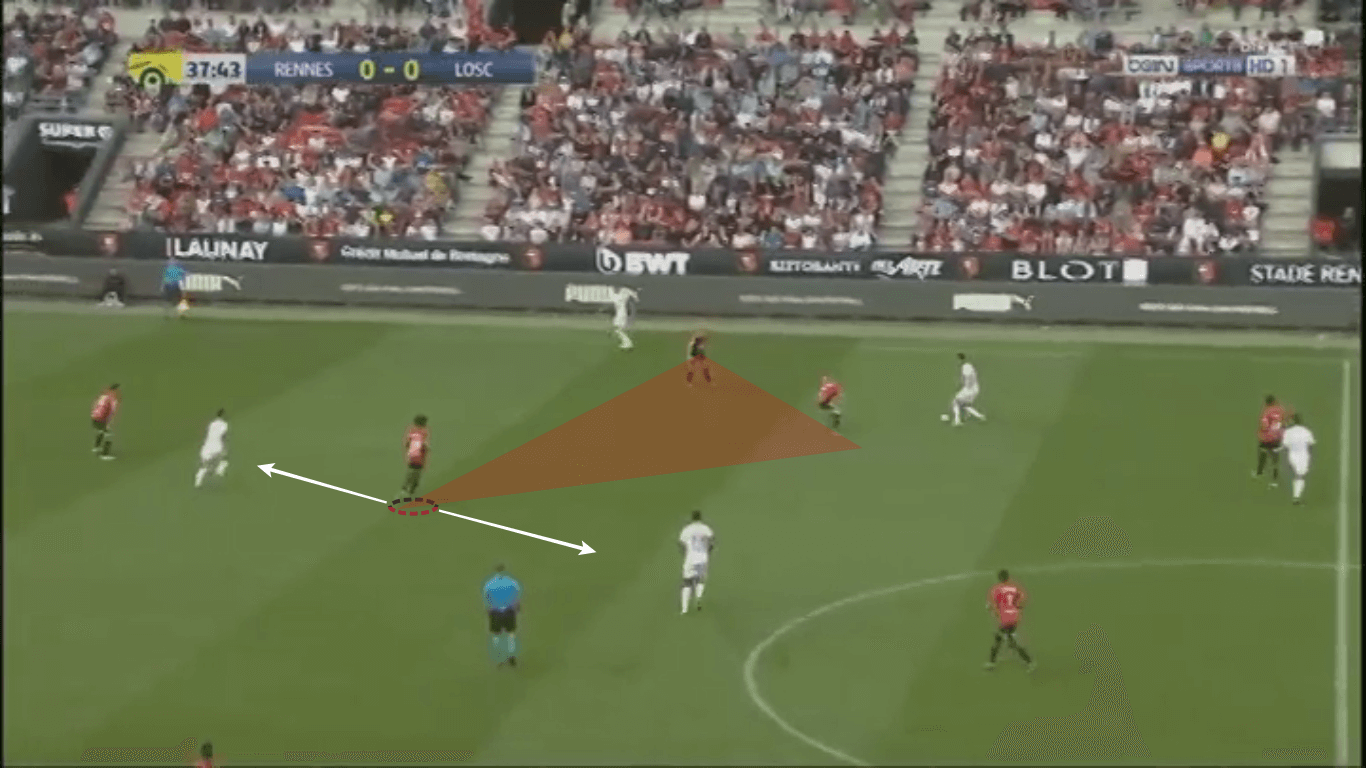
In the picture above, Camavinga stays in support behind his two teammates and watches their backs whilst also covering the two attackers. He is very good in covering depth because he is very disciplined in positioning and doesn’t often leave his position. His team can always count on him sitting back behind the first line of defence controlling the block and covering gaps between the lines.
As the second line of defence, he picks up a lot of breakthrough balls because he is good in “1v1” duels and sticks close to the action. Even though opponents manage to pass through the first part of his team’s pressing, he’s often there to provide correction and win the ball back.
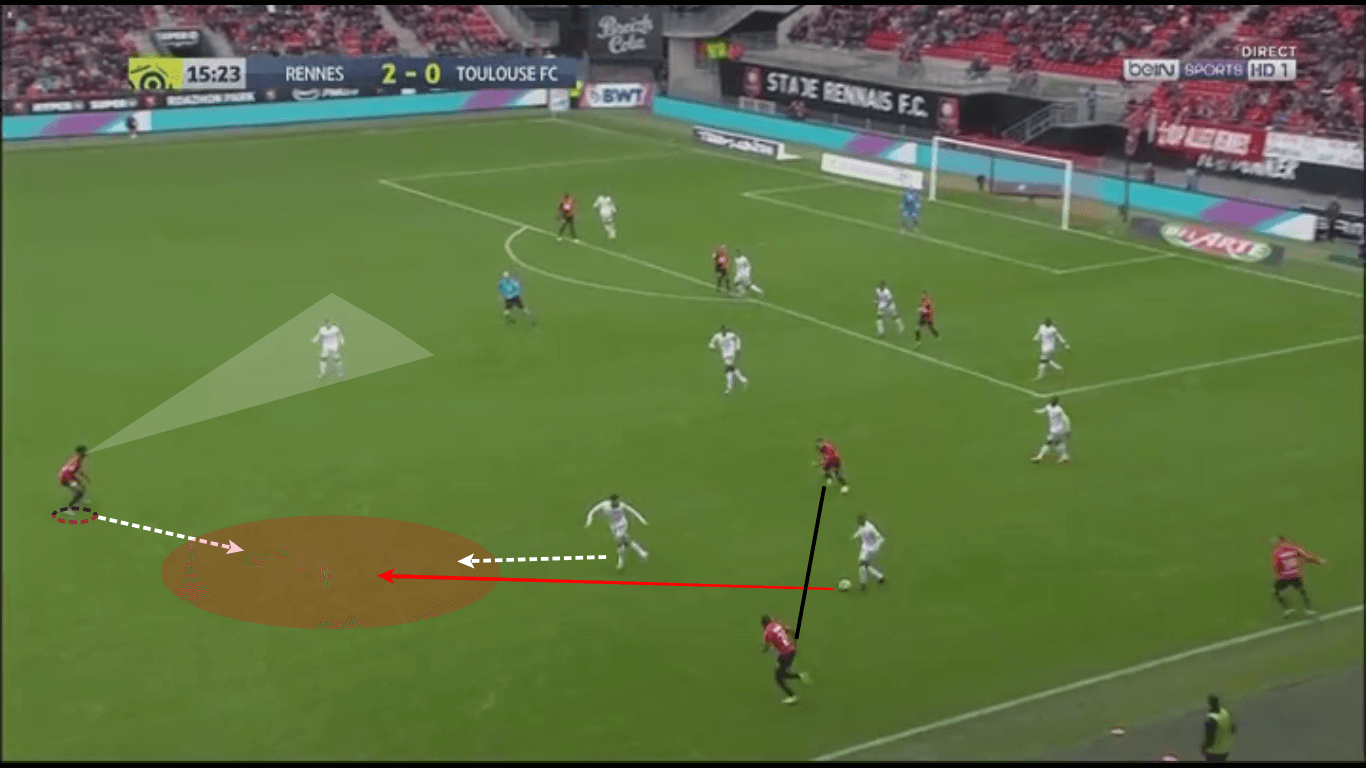
We can see how he manages to come to the zone close to his teammates in order to regain possession with his perfect timing and aggressiveness. Also, he continues to keep an eye on the player in the midfield, staying alerted if he gets the pass and being on standby if that happens.
The same pattern repeats if the player decides to dribble through the first midfield pressing line, as he continues to provide support and be close to them so he could get away with the clear ball or win the second ball.

Camavinga is a disciplined player that moves constantly and covers a lot of space vertically across the pitch. He provides those kinds of helpful runs both on the flanks and in the central areas so he makes the pressing job easier for Rennes.
When it comes to negative transitions, the youngster is pacey and comes deeper to participate in the low-stage defending. His role is, as in the most of the other situations, to cover depth and to cut down the passing lane to the midfielders in central and inner corridors, which he does regularly.
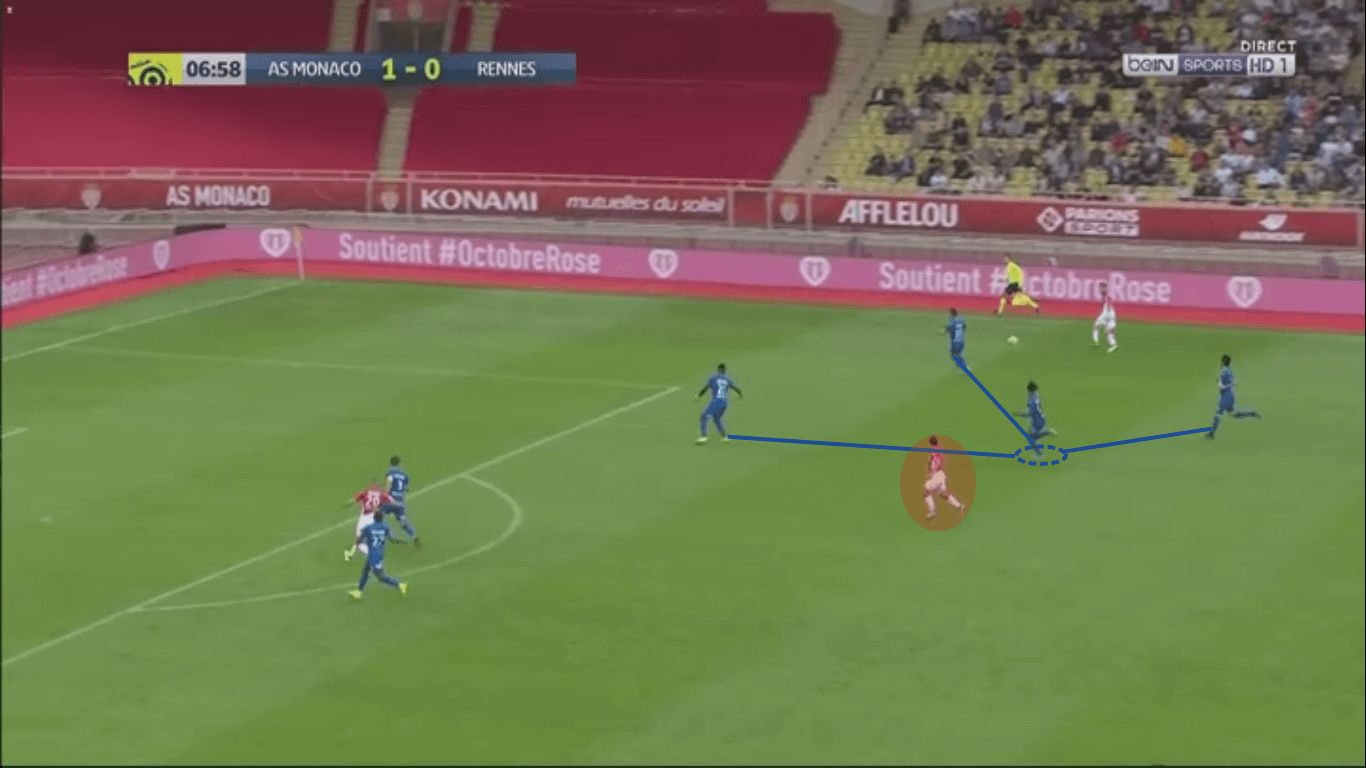
Those settings are possible because of his good communication with the defenders. He manages to keep firm links with them and to be close enough to both the action and the player he needs to guard, maintaining the shape of his team’s transitive system. Although he sometimes forgets himself and doesn’t repeat those runs, that can be accredited to his age and can be seen as the segment of the game in which he can easily become better in the future.
Conclusion
Watching France flourish through the last decade it is clear that they set the grounds for the upcoming generation of players that will fill up the shoes of the likes of Pogba, Griezmann, etc. Their main catalyst in the upcoming years will surely be Kylian Mbappé, but he will have great support in Eduardo Camavinga who is a true embodiment of a modern midfielder.
His on-the-ball skills are in great balance with his out of possession play and he is already a well-built player, yet with a lot of room to fulfil his potential. The youngster’s idea of football is astonishing and the way he dictates matches point him out as the next big thing in the world of the midfield-action.
If he continues to progress this way, he will become one of the hottest players France has had in this millennium mixing in himself qualities of Patrick Viera and Blaise Matuidi. That’s just a comparison you’d love to be part of.

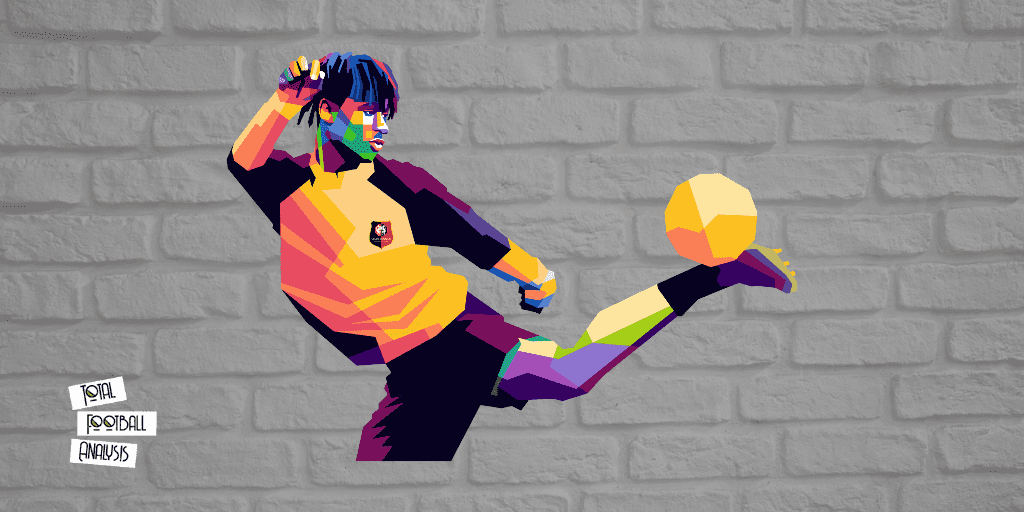


Comments